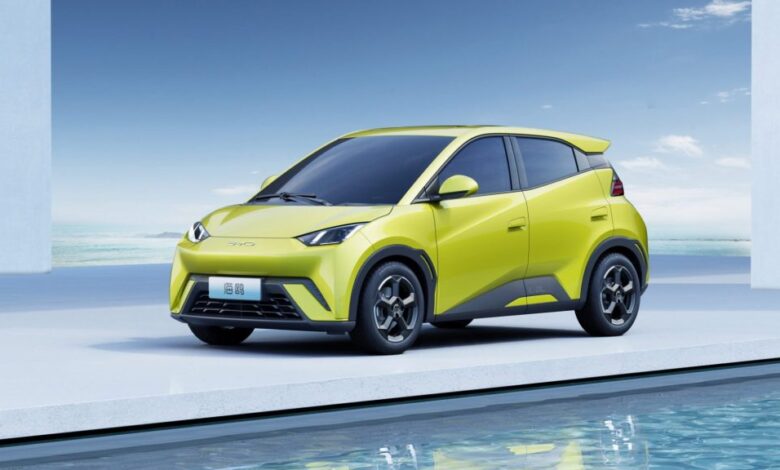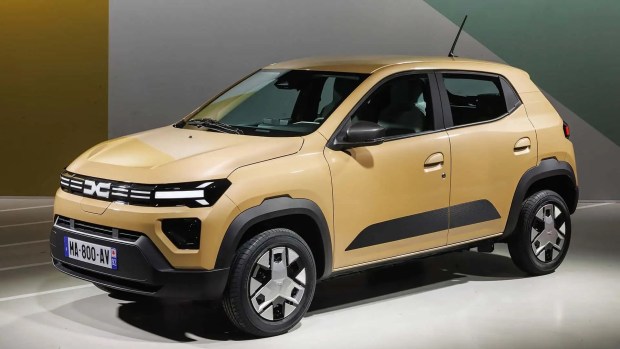When will America get its $25,000 electric car? – Daily Bulletin

The electric BYD Seagull sells for $10,000 in China. (Photo courtesy of BYD)
By Tom Randall
Electric-vehicle prices are falling fast in the US, but the cheapest models remain far more costly than what other countries have on offer. The BYD Seagull sells for about $10,000 in China, the Dacia Spring starts at $20,000 in Europe, the Renault Kwid e-Tech costs $19,000 in Brazil, and the Kia Ray goes for $22,000 in South Korea.
So where is America’s $25,000 EV?
In short, it’s coming soon. It may not seem that way at first glance: US vehicle prices in general have soared to around $47,000, on average, and prices for electric models are higher still. Even after price cuts, the country’s best-selling electric sedan, Tesla’s Model 3, starts at around $40,000.

But with signs of slowing growth in the premium EV market, manufacturers have been working on a substantial pivot from luxury to practicality. The $25,000 economy electric car is the industry’s new target, and a number of models are set to hit the road within a year. Whether they can win over the next wave of American EV owners — and fend off Chinese imports currently held at bay by soon-to-be-102.5% tariffs — depends on how much range and how many features can be squeezed in.
Here’s what we know about four efforts underway:
General Motors revamps the Chevy Bolt
The current US leader in EV affordability may well be the new electric version of the Chevy Equinox. The SUV comes with 319 miles of range for around $42,000, before federal tax credits that can knock $7,500 off the price. Those incentives will drop the cost of a base model, available later this year, below $28,000.
That’s pretty cheap, relatively speaking, but it will soon be outdone by the updated Chevy Bolt. GM’s new North American president, Marissa West, says the Bolt will be “the most affordable vehicle on the market by 2025.”

The original Bolt, which GM discontinued this year, has been the most popular EV alternative to a Tesla in the US for the past seven years. The unassuming car was known for mediocre ride quality, limited range and slow charging — but it won over a loyal fanbase with an unmatched starting price of $26,500 before incentives.
The updated Bolt reduces production costs while improving charging times, styling and handling, according to GM. For charging it will use the new North American Charging Standard, compatible with Tesla’s Superchargers, and employ low-cost lithium iron phosphate batteries on GM’s new Ultium EV platform.
Price and specs haven’t been announced, but it’s a likely contender for best range for the price in the new class of $25,000 EVs.
Stellantis and the $25,000 Jeep Renegade
Stellantis, which has been slow to offer electric models in the US, will launch a $25,000 electric Jeep “very soon” as part of a large-scale EV offensive, Chief Executive Officer Carlos Tavares said at a Bernstein conference on May 29. Stellantis later confirmed that the EV would take on the Jeep Renegade brand and would be one of at least three new Jeeps on sale in the US by 2027. Stellantis brought its first EVs to the US this year: the $32,500 Fiat 500e subcompact car, and the Wagoneer S that starts around $70,000. At $25,000, the new model would be the cheapest Jeep of any type available in the US, undercutting the gas-powered Compass compact crossover at $26,000.
Surviving the transition to electric vehicles, Tavares said, requires offering prices comparable to gas-powered vehicles, even if that means severe cost cuts and fewer profits across the supply chain during the transition years. Reaching economies of scale is key.
“If you ask me what is an affordable [battery electric vehicle], I would say €20,000 in Europe and $25,000 in the US,” Tavares said. “So our job is to bring the safe, clean and affordable BEV to the US — $25,000 — we’ll do it.”
Ford goes back to the drawing board
After being burned by high costs and underwhelming demand for its first two EVs, Ford reversed course. It cut spending on battery-powered models by $12 billion, postponed battery plants and delayed an electric F-Series pickup and a three-row SUV until 2026 and 2027, respectively.
Having decided that big electric SUVs and trucks are too pricy for mainstream customers, now Ford is thinking smaller. Two years ago, the company quietly started development on a more affordable line of EVs. The work is being done by a satellite team of engineers in Irvine, California, run by Alan Clarke, who previously led engineering for Tesla’s Model Y SUV.
The first of three new EVs on that platform will arrive late 2026, with a starting price around $25,000, according to reporting that first appeared in Bloomberg Businessweek and was later confirmed by CEO Jim Farley. He said Ford’s new goal is clear: to create mainstream EVs that are profitable within a year on the market. That’s in stark contrast to the losses incurred by its current lineup.
Ford’s internal customer data shows most EV buyers live in the suburbs, drive relatively short distances, and care more about cost than high-end features, Farley said on an earnings call in April. “That’s where adoption of EVs will grow the fastest,” he said. “Increasingly, our bet will be on our new small affordable platform developed by our team on the West Coast.”
Unboxing Tesla’s mystery EV
Tesla, the world’s leading producer of fully electric cars, has been the biggest source of pressure to develop a $25,000 car in the US — and also the biggest source of uncertainty. Musk has talked up a $25,000 Tesla for years in public, while apparently arguing against it in private. Reports suggest he told suppliers in January to prepare for a mid-2025 launch, then told his engineers in April to scrap those plans altogether. Musk flatly denied shuttering the program, but then refused to say he remains committed.
If the goal was to leave everyone guessing, well, mission accomplished.
At the heart of the matter is whether Tesla will prioritize making small, low-cost vehicles that can compete with the rising sea of Chinese challengers, or whether it will focus first on building cars for a moonshot self-driving taxi. Only Musk knows why the two are mutually exclusive, and at least far now, he isn’t sharing.
On an earnings call in April, Musk said Tesla has accelerated, rather than delayed, its future-products roadmap and that “more affordable models” are coming in late 2024 or early 2025. Those models will be produced on Tesla’s existing production lines, rather than using the experimental production method, which Musk calls “unboxed,” that was originally planned.
Tesla confirmed last week that three vehicles are in development — presumably the Roadster supercar announced in 2017, the driverless Cybercab robotaxi to be unveiled in August, and the yet-to-be-named budget vehicle.
What will come of it all is anyone’s guess, but if Tesla were able to win over American drivers with a tiny lightweight personal vehicle in the way it did for large electric SUVs, that could do more to transform US roadways and reduce road pollution than anything the company has done so far. Except this time, with the $25,000 EV segment, Tesla won’t be the only one trying.
With assistance from Albertina Torsoli.



